Nebraska is a Midwestern State with a huge biodiversity. It’s home to about 1500 species of plants, 450 different birds, 95 big and small mammals, 61 amphibians, and 106 kinds of fish. Not to mention the 28,000 insect species!
That’s why naturalists and birdwatchers never have a dull moment in this part of the world.
In this article, we’ll take a closer look at 25 birds in Nebraska. We’ll also give you all the practical tips on how to find and identify them.
Red Birds in Nebraska
Summer Tanager
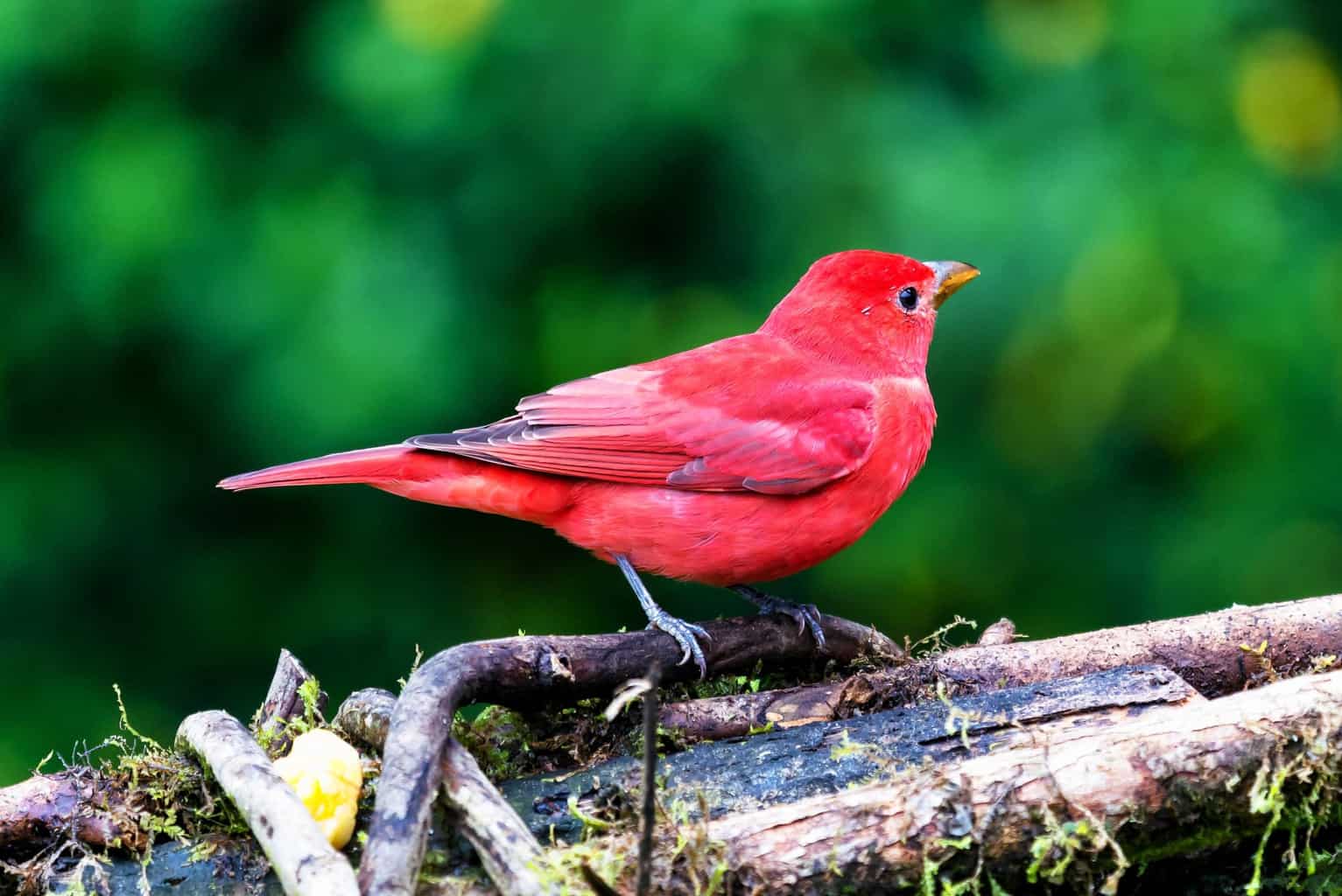
- Scientific Name: Piranga rubra
- Length: 6.7 in
- Weight: 1.1 oz
- Wingspan: 11-12 in
Additional Information:
Male Summer Tanagers are strawberry-red from tip to toe. Thus, they aren’t too hard to spot. Whether they’re perching on the branches of a canopy or catching insects on the fly.
The female Summer Tanagers are harder to spot though, as they’re mostly a greenish-mustard color. They tend to merge with the foliage.
These birds are migratory, so you’d mostly see them during the summer, but there’s a good chance that they’ll stay through the fall, and only travel south when it gets really cold.
Northern Cardinal

- Scientific Name: Cardinalis cardinalis
- Length: 8.3-9.1 in
- Weight: 1.5-1.7 oz
- Wingspan: 9.8-12.2 in
Additional Information:
Northern Cardinals are picturesque birds that most people hope to see up close. The males are mostly red with a black patch around their bills. The females have a bit of red color on them as well, and they both share magnificent crests on their heads.
These birds stay put all year round and rarely show an inclination to travel. Additionally, they don’t molt, so birdwatchers get to enjoy their perky songs and bright presence at all times.
These birds are sociable, and you could invite them to your backyard feeder if you offer them sunflower seeds. They might even decide to nest there. Northern Cardinals are pretty territorial as well, and they’d do much to defend their favorite places.
Red-Headed Woodpecker
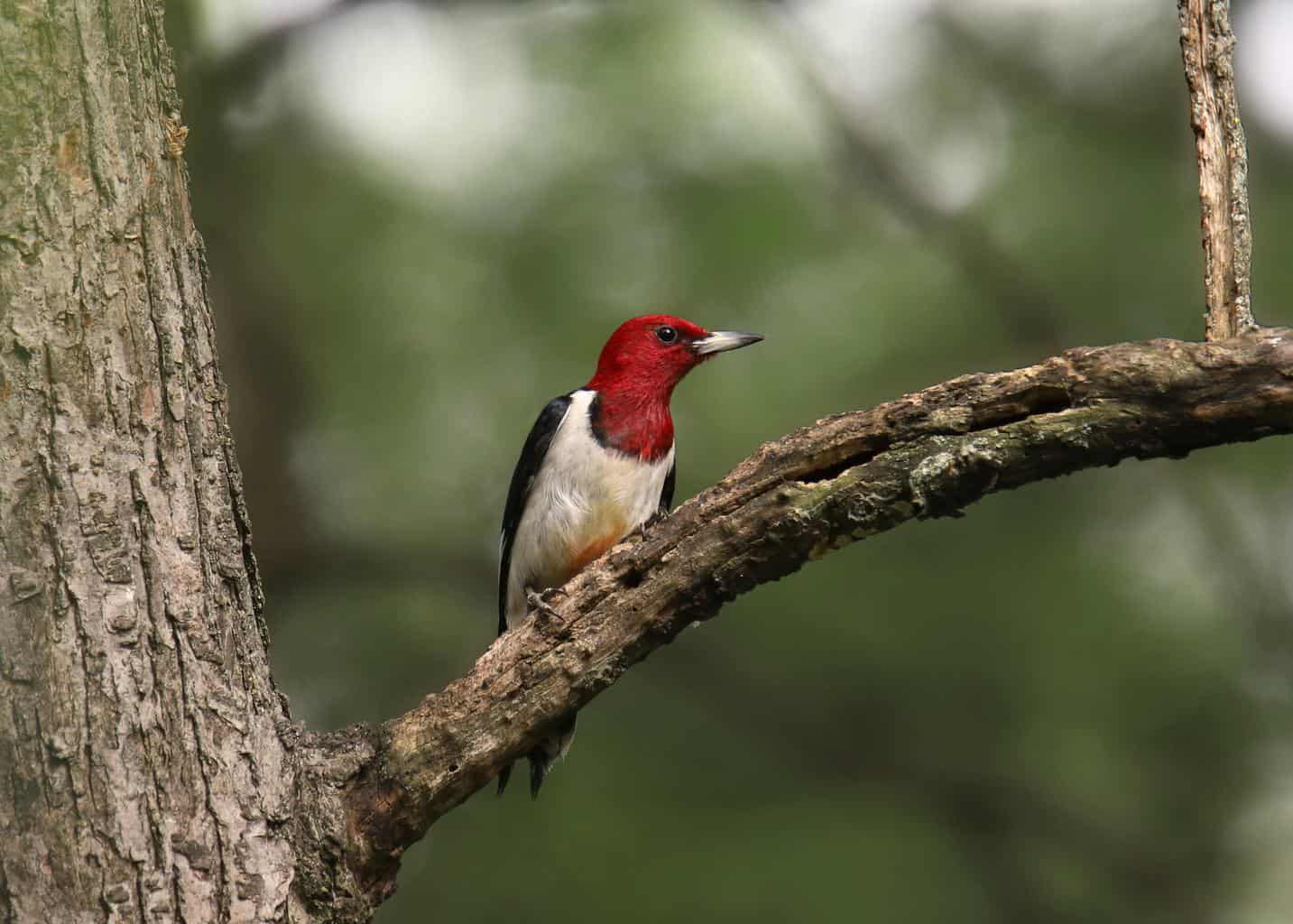
- Scientific Name: Melanerpes erythrocephalus
- Length: 7.5-9.1 in
- Weight: 2.0-3.2 oz
- Wingspan: 16.5 in
Additional Information:
The Red-headed Woodpecker is a large bird that’s almost as big as a crow. It’s characterized by a crimson-red head, a white belly, and a contrasting black back.
This woodpecker only gets these bright colors upon adulthood, so the young ones appear rather bland and inconspicuous.
A large bird like the Red-headed Woodpecker is expected to have a healthy appetite. Clearly, it does, as it welcomes a meal of insects, acorns, or nuts. It actually stocks these foods in trees and often has a hidden stash of goodies for a rainy day.
Sadly, the numbers of these woodpeckers have decreased significantly over the years. Primarily as they live in woodlands, which consistently decreased due to urbanization and land development.
Rose-Breasted Grosbeak
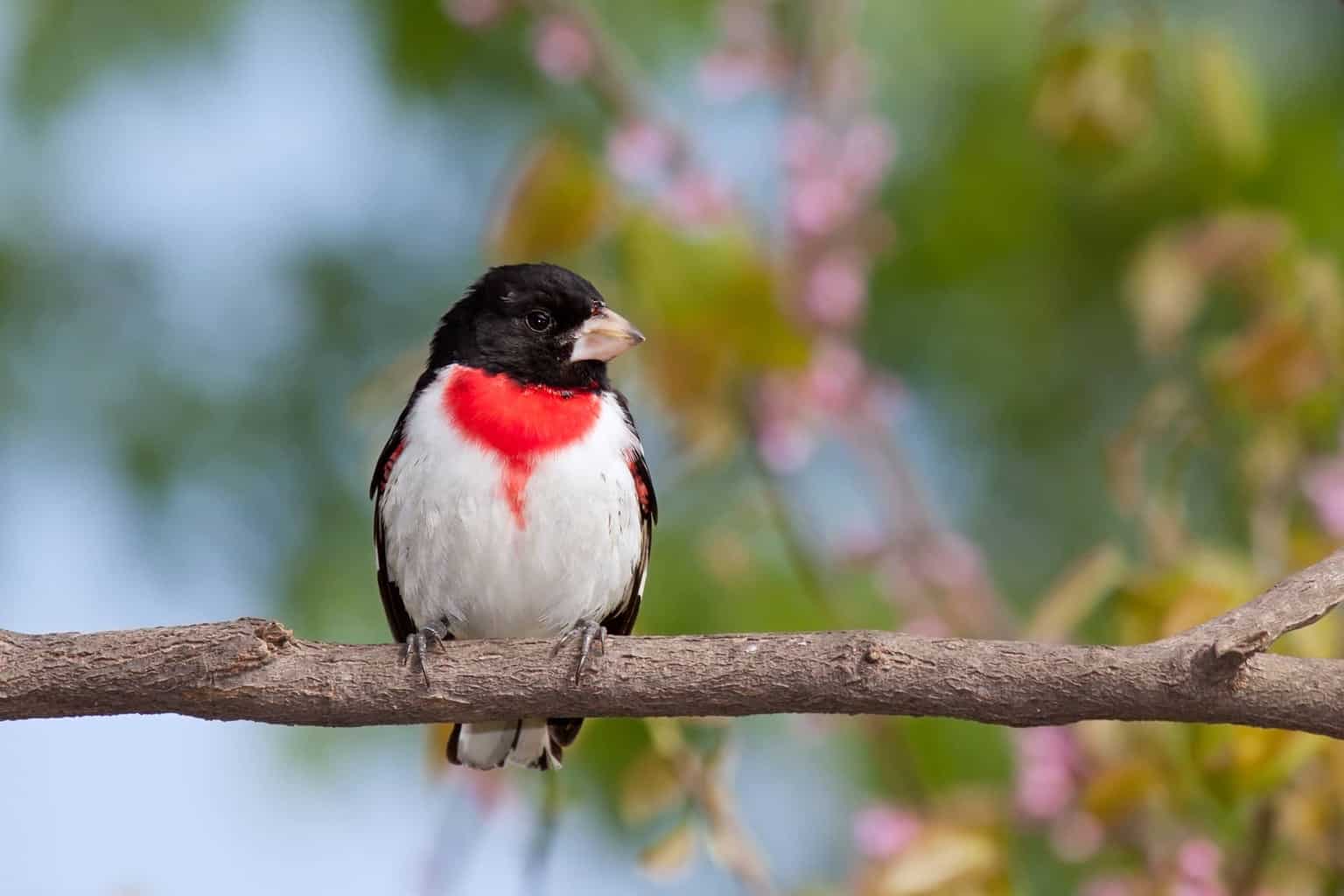
- Scientific Name: Pheucticus ludovicianus
- Length: 7.1-8.3 in
- Weight: 1.4-1.7 oz
- Wingspan: 11.4-13.0 in
Additional Information:
The Rose-breasted Grosbeak shares a few similarities with the Red-headed Woodpecker. Mainly, the red, white, and black bold colors. They differ in the placement of the colors though, as the Rose-breasted grosbeak has a red patch on its chest.
They also share the same habitat, as they often take up residence in woodlands. These birds are also a bit plump and have extra-thick bills. The females are as big as the males, but they totally lack the colors.
Rose-breasted Grosbeaks feed on insects as well as seeds, so you might find them hopping around your backyard feeder. You can also find them if you follow their unmistakable melodic whistling songs.
Scarlet Tanager
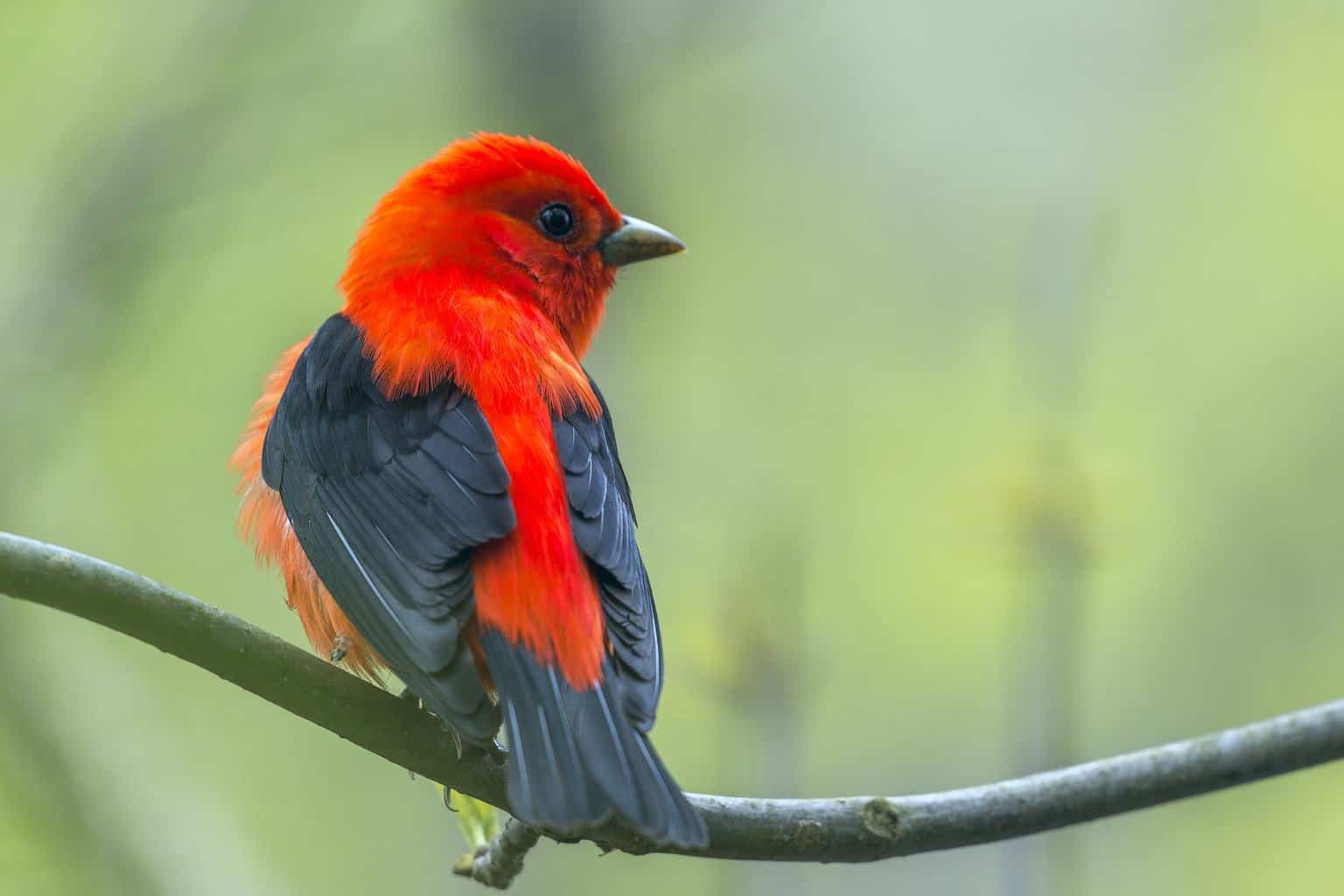
- Scientific Name: Piranga olivacea
- Length: 6.3-6.7 in
- Weight: 0.8-1.3 oz
- Wingspan: 9.8-11.4 in
Additional Information:
The adult males Scarlet Tanagers are breathtakingly beautiful little birds. They have the deepest red color that contrasts with their coal-black wings, tail, and beady eyes.
Their bright red coloring doesn’t help much in spotting them though, as they spend most of their time singing high in the canopies. The females are even more difficult to find, as they have a dark color that’s similar to the foliage. Their distinctive calls are your best bet at finding them.
Around the fall, the males lose their characteristic red feathers and morph into a cool green. Soon afterward, they take off and migrate to the warmer south.
Blue Birds in Nebraska
Steller’s Jay
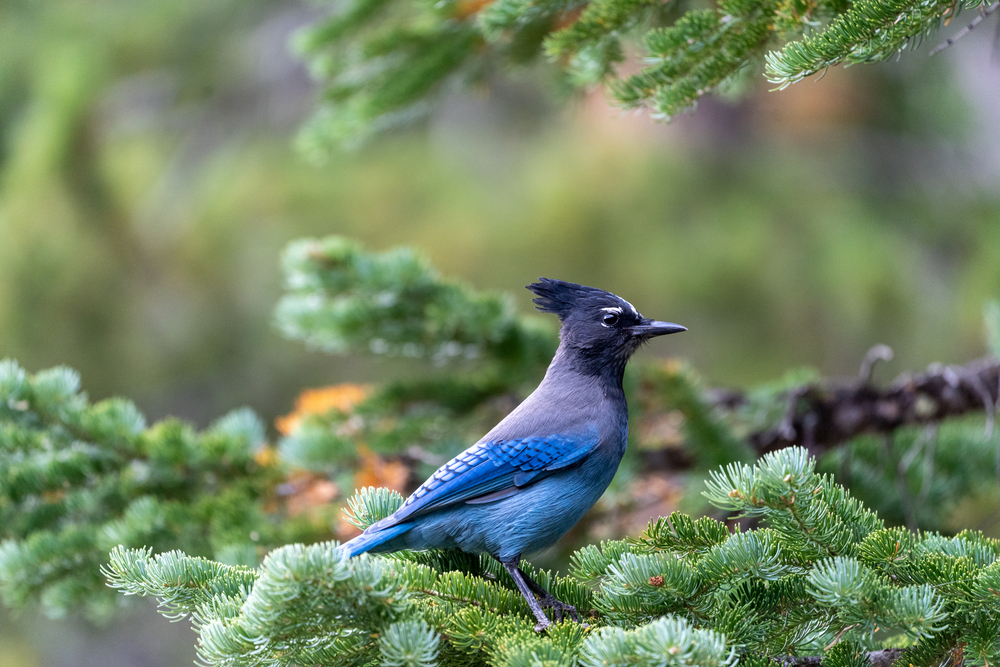
- Scientific Name: Cyanocitta stelleri
- Length: 11.8-13.4 in
- Weight: 3.5-4.9 oz
- Wingspan: 17.3 in
Additional Information:
Steller’s Jay is among the bird watcher’s absolute favorites. It’s half-blue and half black, with a prominent crest and long tail. The coastal varieties have blue streaks at the front of their crests, while the mountain jays have white streaks.
These birds take residence in woodlands edging mountain or coastal areas. It might be a tad difficult to spot them there as they favor the dense canopies. You might also see them around bird feeders, gardens, parks, or camping grounds.
They’re omnivores and often like to check out the goodies and food items humans are having. That’s why they hover around picnic tables or camping cookouts. Either they get a generous handout, or they help themselves to some of their favorite foods!
Cerulean Warbler
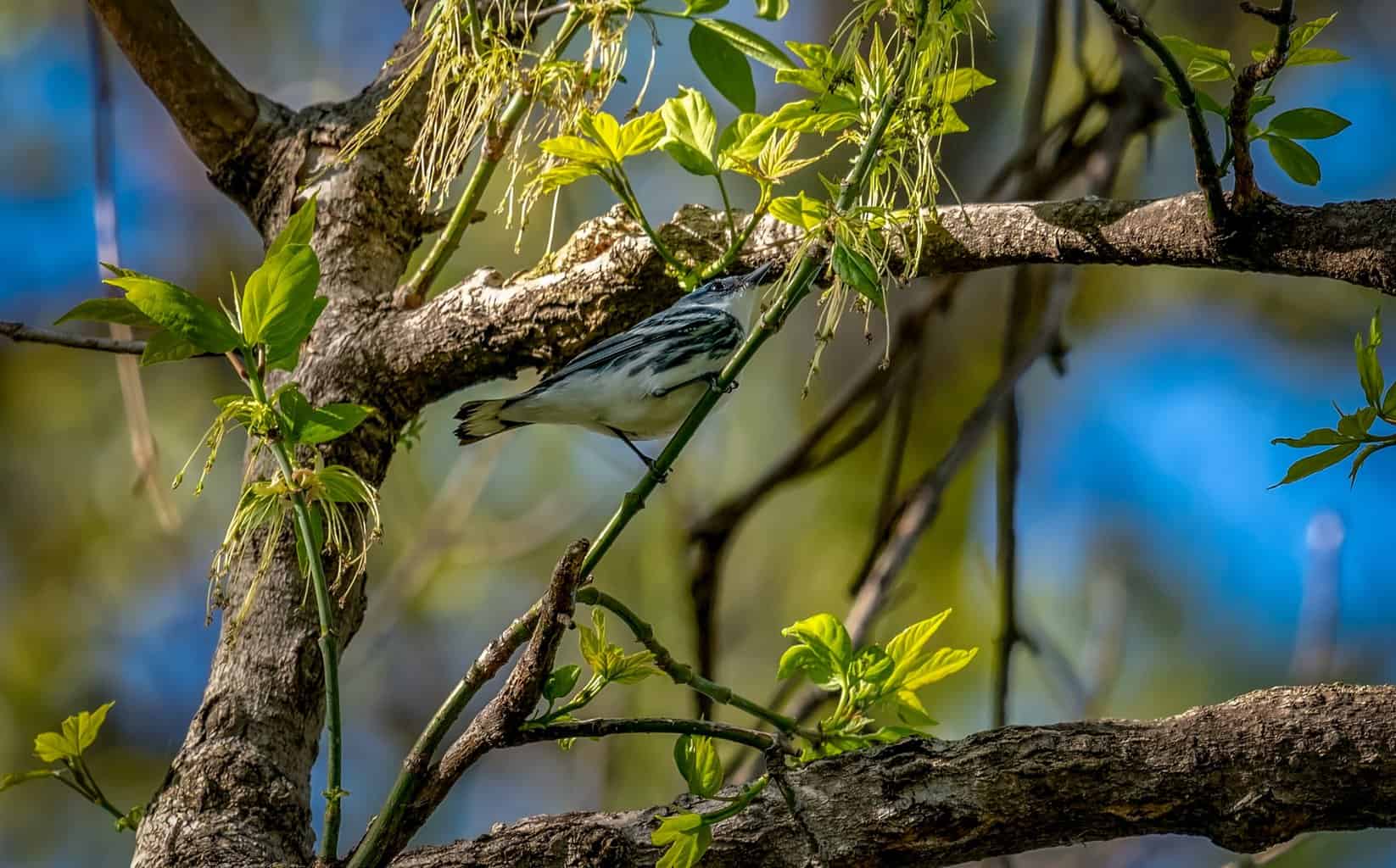
- Scientific Name: Setophaga cerulea
- Length: 4.3 in
- Weight: 0.3-0.3 oz
- Wingspan: 7.9 in
Additional Information:
Cerulean Warblers are tiny little birds, barely the size of sparrows. The adult males have a unique winter-sky coloring, while the females have a greenish-blue tint.
These migratory birds are hard to spot. Firstly, because they are seasonal. And secondly, they live mainly in the forests, and their habitat has declined severely in recent years.
Cerulean Warblers are sociable birds that share their nesting areas with other bird species, especially tanagers.
These birds have a distinctive acrobatic stunt, as they bungee-jump from their nests, with their wings folded. They only start flapping their wings as they come very close to the ground!
Tricolored Heron
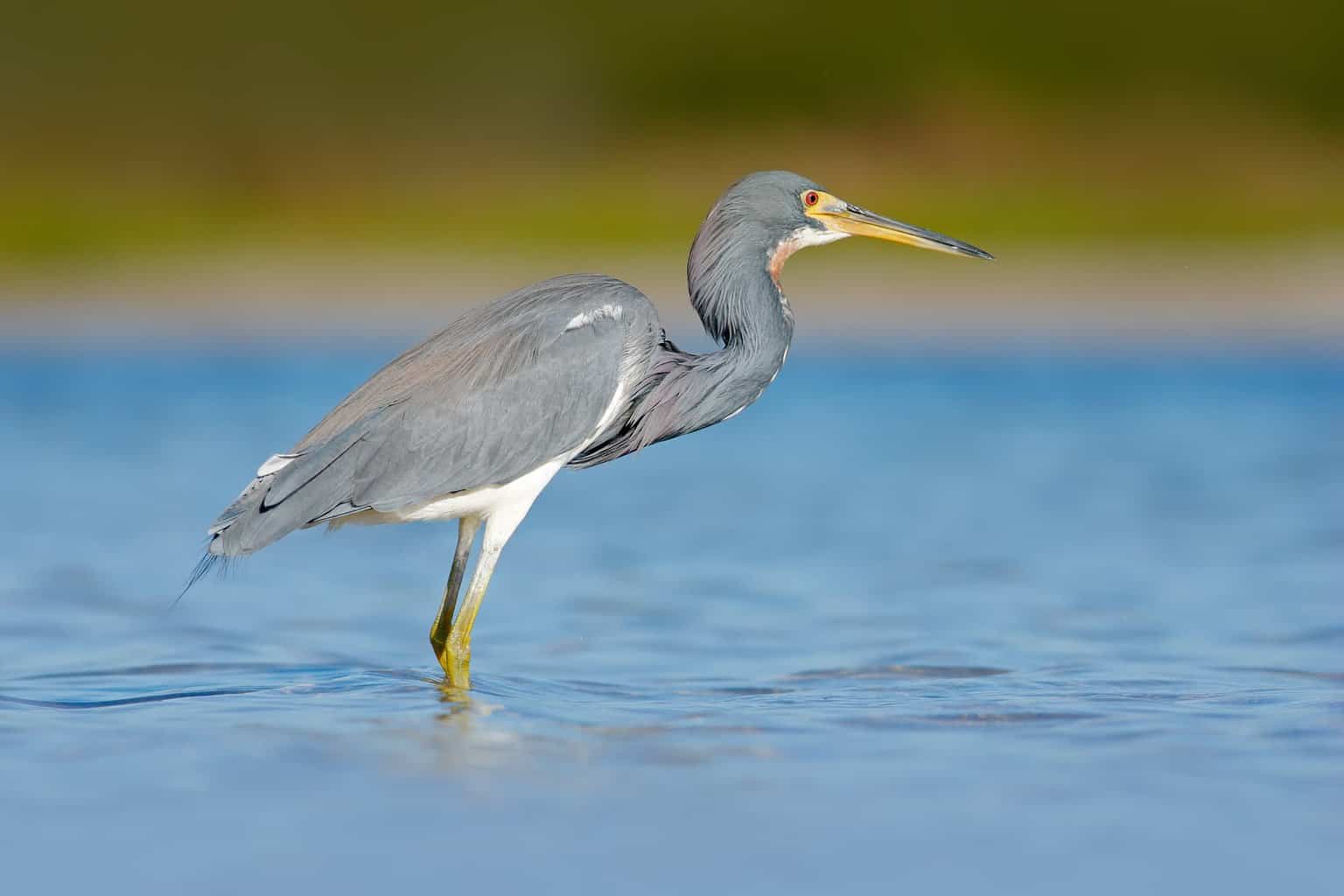
- Scientific Name: Egretta tricolor
- Length: 23.6-27.6 in
- Weight: 14.6 oz
- Wingspan: 37.4 in
Additional Information:
Tricolored Herons have an interesting blue, purple, and white color combination. These slender birds have dagger-shaped bills that are well adapted for their culinary preferences, and strong long legs that help a lot while wading in the water.
These colored Herons build their nests from sticks and often place them on low-hanging branches or shrubs. They live as close as possible to salt marshes, where they spend a good deal of their time plucking fish out of the shallow water. They might also venture into open waters or lakes if they feel like it.
These big birds have long lifespans, as they don’t have too many predators, and seem to find no shortage of food. The oldest Tricolored Heron in the records lived almost 18 years.
Mountain Bluebird
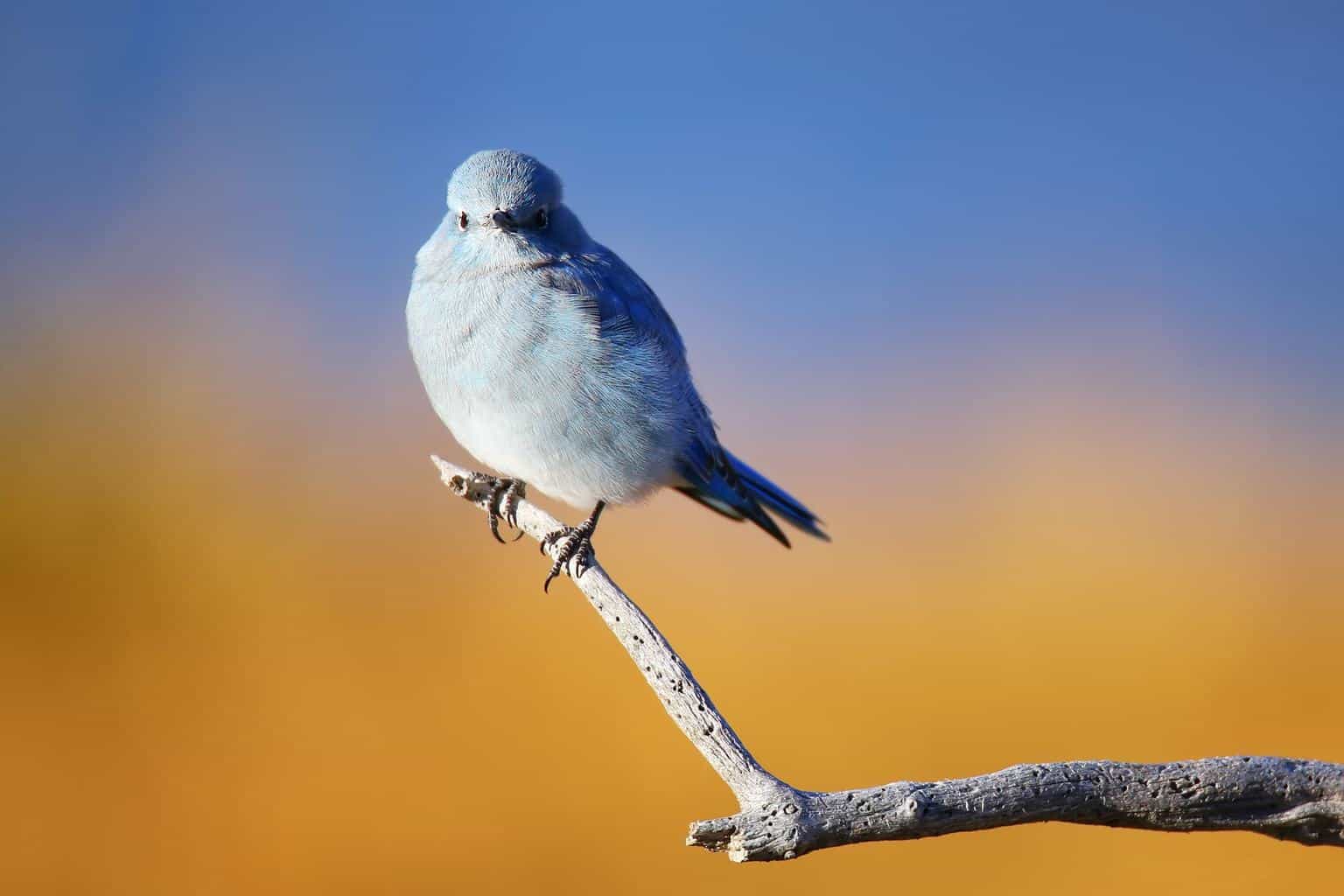
- Scientific Name: Sialia currucoides
- Length: 6.3-7.9 in
- Weight: 1.1 oz
- Wingspan: 11.0-14.2 in
Additional Information:
The Mountain Bluebird is one of the cutest thrushes that inhabit the open woodland. The adult male is sky-blue, plump, and slightly larger than a swallow. It has a small pointy bill that helps in catching insects on the fly.
The females share the same size and general features as the males, except for the color. They’re mostly beige with hints of blue on their tails and wings.
These cute birds aren’t timid, and they frequently venture out of the dense forests onto the mountain slopes and meadows. It’s not difficult at all to spot a whole bunch of Mountain Bluebirds if you know where to look for them.
Barn Swallow

- Scientific Name: Hirundo rustica
- Length: 5.9-7.5 in
- Weight: 0.6-0.7 oz
- Wingspan: 11.4-12.6 in
Additional Information:
People often expect the Barn Swallow to be the size of a Robin, owing to its round plump shape, broad shoulders, and seemingly stout physique. However, in reality, these birds are quite tiny. They’re barely as big as a swallow.
The full colors and shape of the Barn Swallow appear when it takes flight. Its back is a metallic cobalt blue that turns into a purplish grey around the wings and tail. Its belly is beige and it has a rust-colored patch on its throat and around its head.
You can tell a Barn Swallow from similar birds by the long feathers that form a fork in its tail.
You can spot it flying over corn plantations, and if you’re lucky, you can see its acrobatic agile maneuvers as it catches an insect in midair.
These birds build cone-shaped nests made from mud, and interestingly, they almost always choose a human building to place their nests.
Green Birds in Nebraska
Mallard
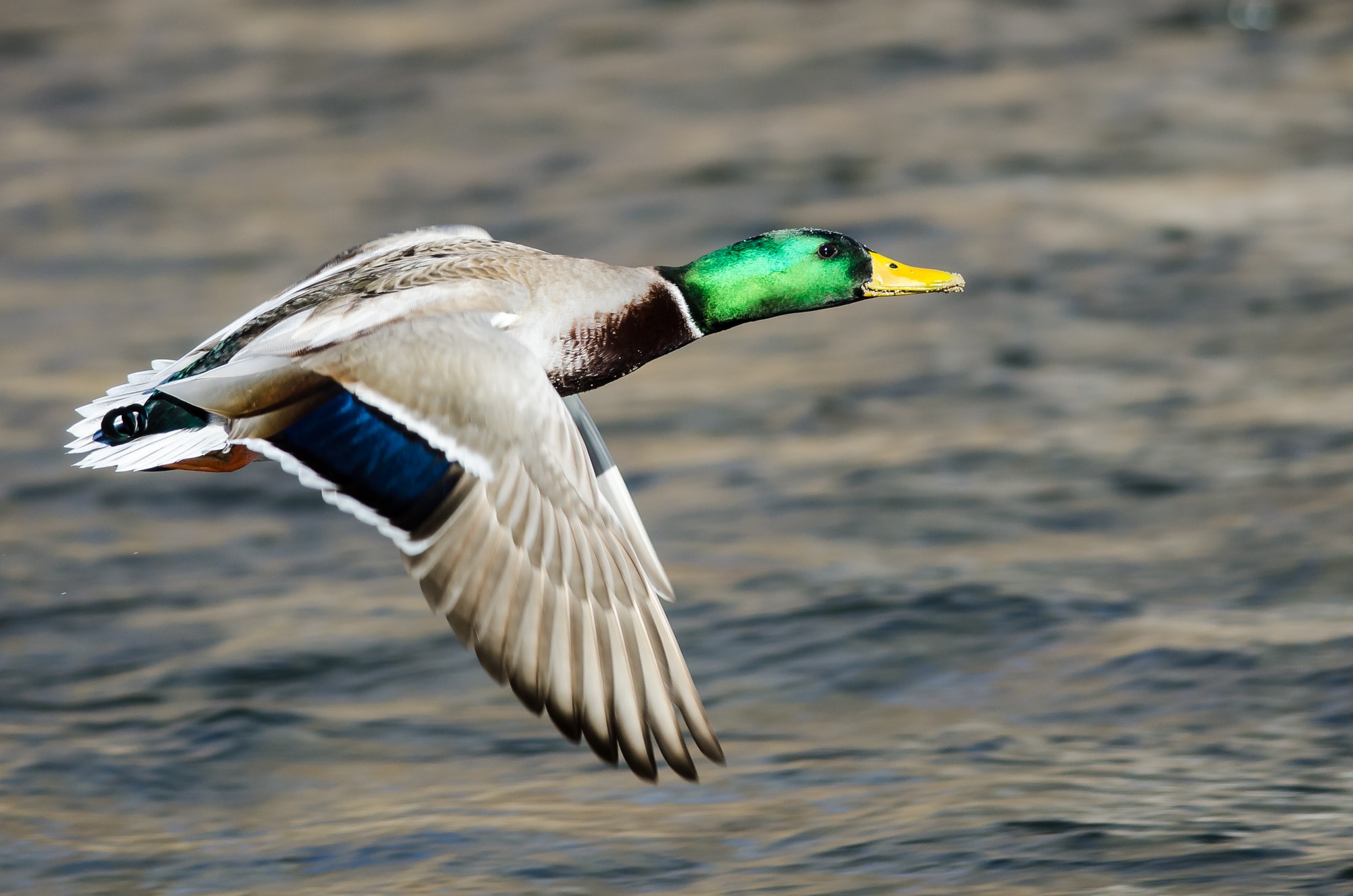
- Scientific Name: Anas platyrhynchos
- Length: 19.7-25.6 in
- Weight: 35.3-45.9 oz
- Wingspan: 32.3-37.4 in
Additional Information:
Mallards are large ducks with unmistakable deep green heads. That’s an exclusive trait for the breeding males though. Their bodies are covered in colored feathers, but they’re known to molt by the end of the nesting season.
The females and juvenile Mallards are quite similar to domestic ducks with their patterned brown and beige feathers.
Mallards are omnivores with a healthy appetite, so you’ll often see them dabbling in the water, looking for small invertebrates or savory plants.
These ducks seem to like the company of humans, so they easily take to park ponds, lakes, and even residential pools.
Violet-Green Swallow
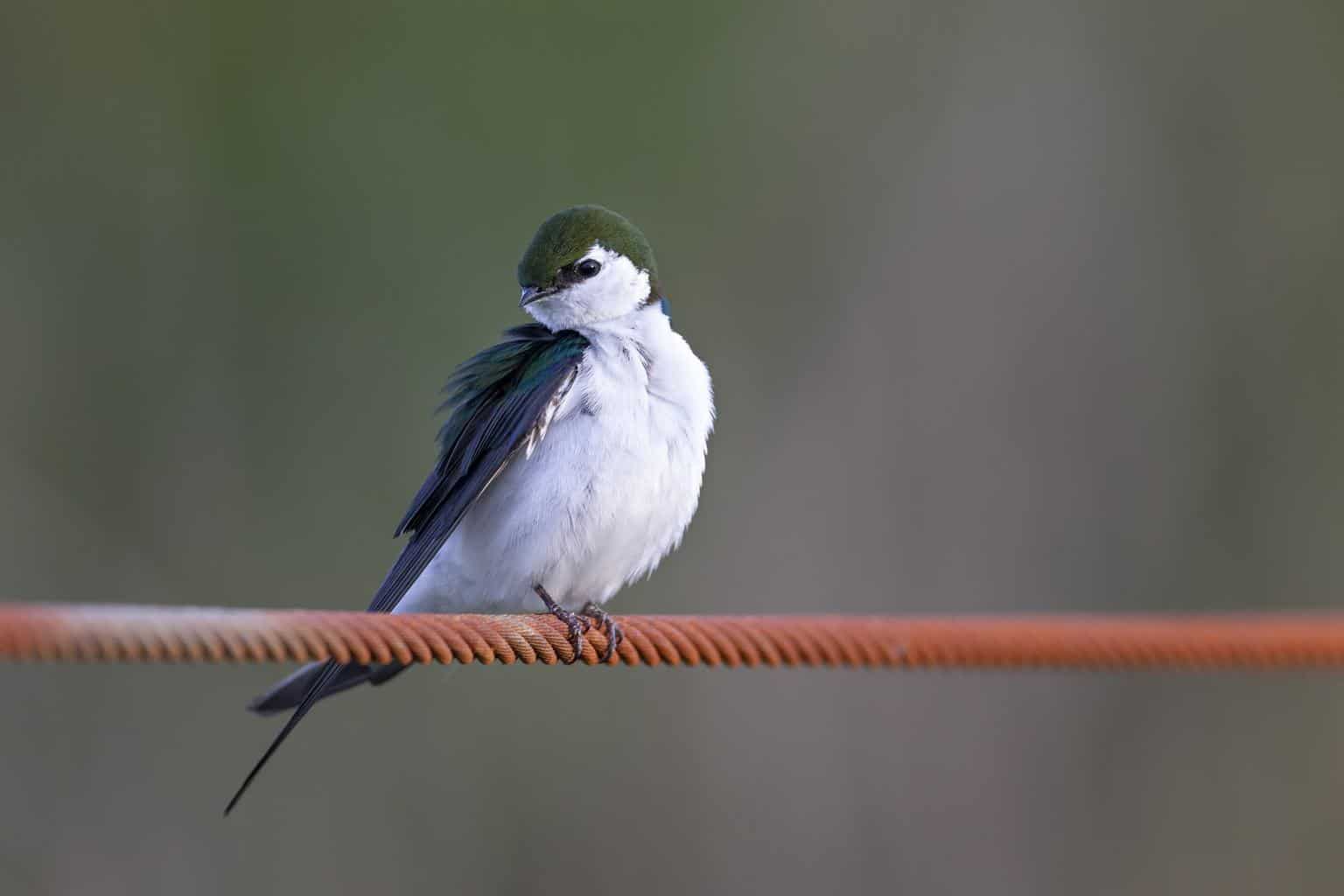
- Scientific Name: Tachycineta thalassina
- Length: 4.7 in
- Weight: 0.5 oz
- Wingspan: 10.6 in
Additional Information:
Violet-green Swallows have snow-white bodies which bring out their olive-green heads, foliage-green backs, as well as the purple gradations on their wings and tails.
The females are a diluted version of the males, as they have a similar appearance, but in washed-down colors.
You can see these little swallows with their iridescent colors in the spring and summer. But as soon as the cold winds blow, they’ll fly off south.
Look for them around woodlands and lakes. They often set up small bird communities, so they’re pretty easy to spot.
Northern Shoveler

- Scientific Name: Spatula clypeata
- Length: 17.3-20.1 in
- Weight: 14.1-28.9 oz
- Wingspan: 27.2-33.1 in
Additional Information:
The Northern Shoveler is an unmistakable duck with its large green head, cinnamon flanks, and black extra-large spoon-bill. As usual, the female is small, bland, and doesn’t have any special markings, except for an orange bill.
This shoveler duck is an omnivorous dabbler that constantly dips its head into the water in search of a snack. Northern Shovelers are fond of tiny crustaceans and similar invertebrates. But they wouldn’t mind munching on seeds whenever they find them.
Most Northern Shovelers have long lives that could extend to 17 years. Additionally, they tend to stay monogamous. At least throughout the seasons between migrations.
Broad-Tailed Hummingbird

- Scientific Name: Selasphorus platycercus
- Length: 3.1-3.5 in
- Weight: 0.1-0.2 oz
- Wingspan: 5.25 inches
Additional Information:
Adult male Broad-tailed Hummingbirds are mostly green, with white chests, and purple scale-like feathers on their throats. The females have deeper colors, but they miss the flashy decorative throat feathers. Instead, they have green spots.
These hummingbirds are easy to spot in the woodlands and mountain areas. Their metallic colors and distinctive cries are nice guides to follow.
In springtime, the males proudly flaunt their good looks and perform agile acrobatics to get the females’ attention.
As soon as they get their courtship going, they build a nest at extremely high altitudes, exceeding 10,000 feet. The males have a tendency to leave the nest then, and the moms take over caring for their hatchlings.
Orange Birds in Nebraska
Western Tanager
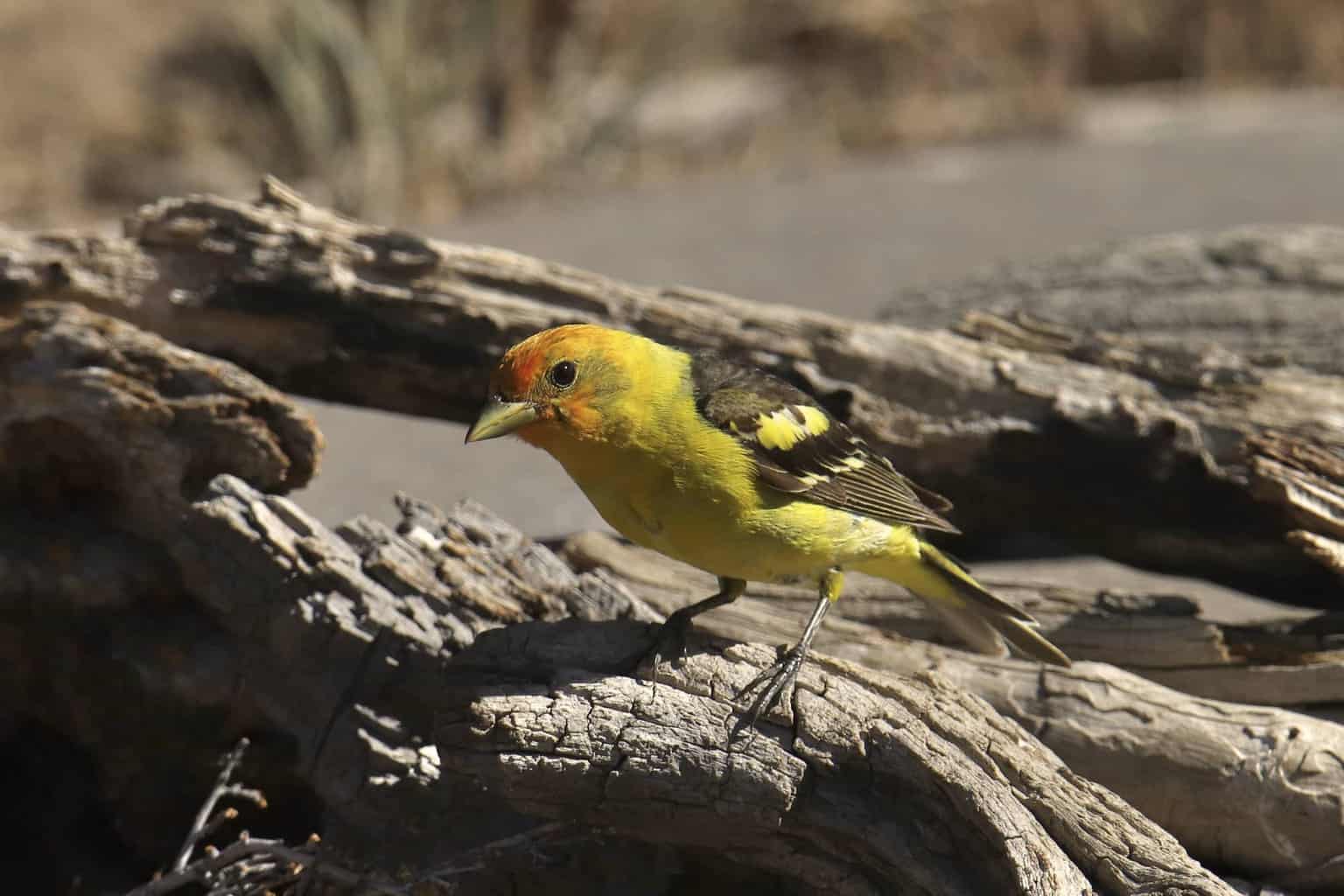
- Scientific Name: Piranga ludoviciana
- Length: 6.3-7.5 in
- Weight: 0.8-1.3 oz
- Wingspan: 11.5 in
Additional Information:
Western Tanagers are brightly colored types of birds, a little bigger than a swallow. The adult males have bright orange foreheads, yellow bodies, and black wings. The females have similar patterns but in a toned-down manner. They’re also a bit smaller.
These birds typically take residence in open woodlands, and they seem to prefer hiding within the foliage. Their calls and songs give them away though, especially, since they live among crowded communities.
Baltimore Oriole
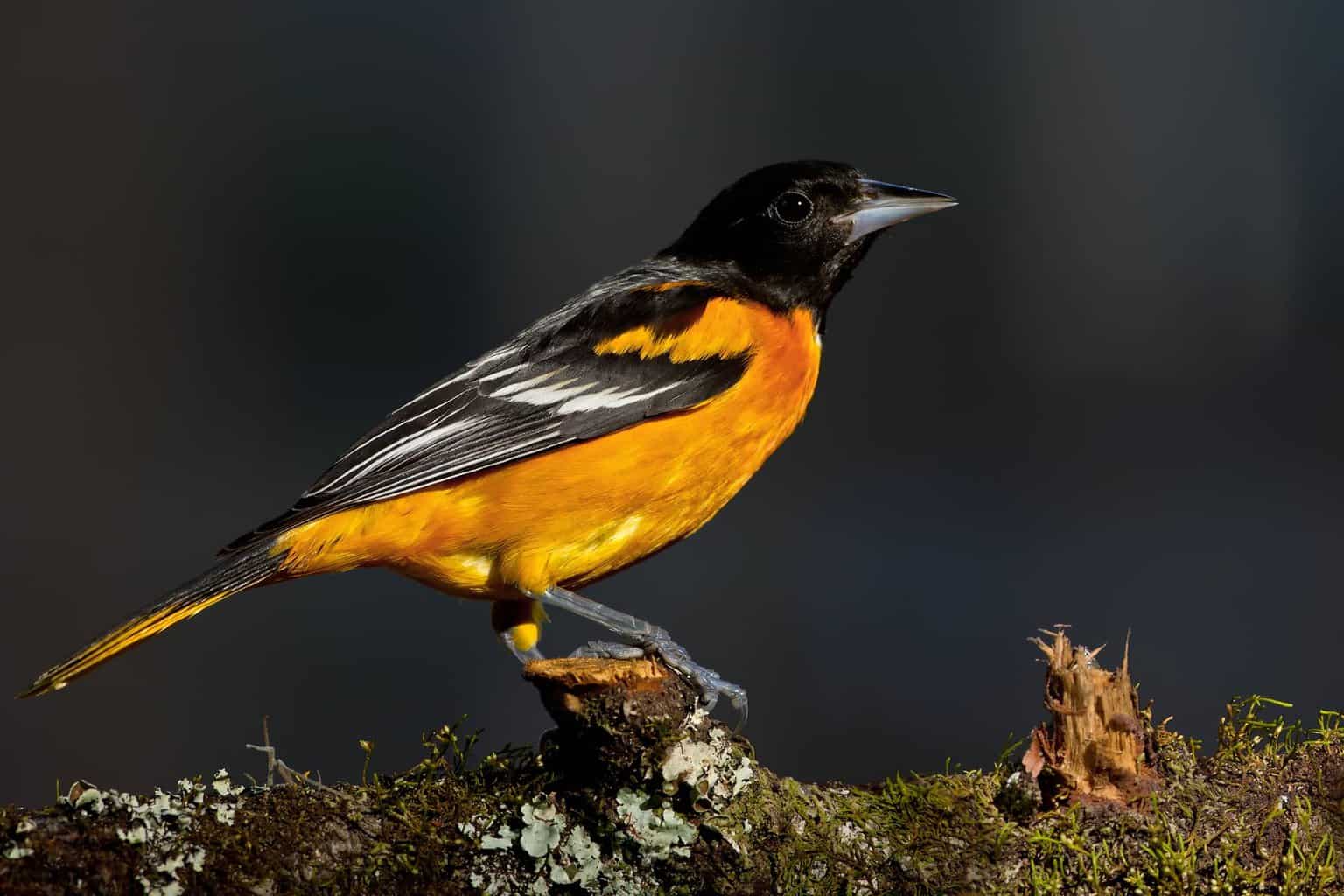
- Scientific Name: Icterus galbula
- Length: 6.7-7.5 in
- Weight: 1.1-1.4 oz
- Wingspan: 9.1-11.8 in
Additional Information:
Baltimore Orioles are Robin-sized birds, with cone-shaped bills, and long legs. The males are black and bright orange, while the females are paler overall.
These songbirds aren’t too picky when it comes to their favorite residence. Their ideal habitat is in the open woodlands, but you can also find them in gardens and parks.
You can even lure them to a backyard feeder by offering them fruits. They’re very fond of nectar as well, so you can leave them little bowls containing sugary syrup. And if you have fruit trees around the feeder, that’s even better.
Bullock’s Oriole
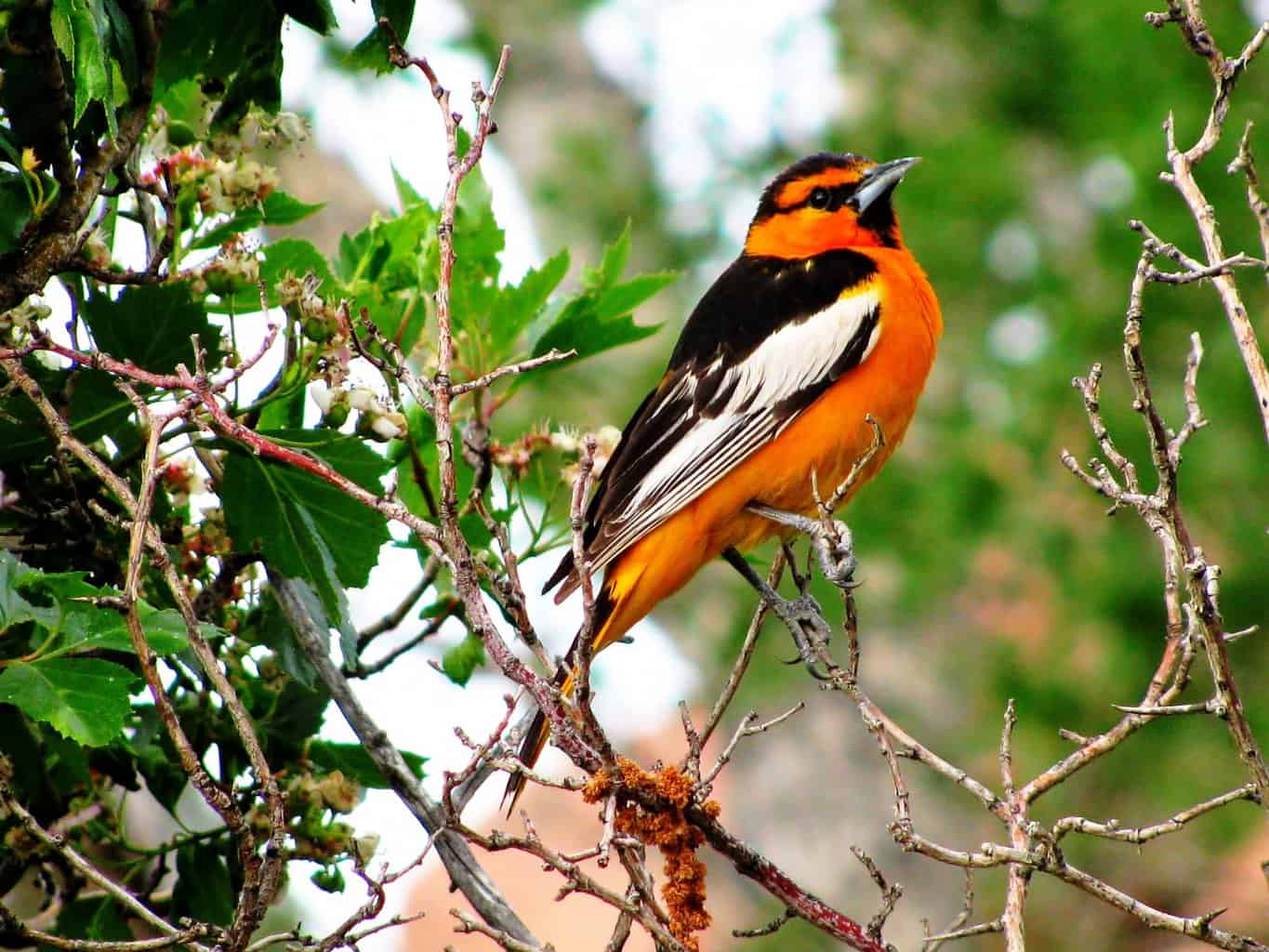
- Scientific Name: Icterus bullockii
- Length: 6.7-7.5 in
- Weight: 1.0-1.5 oz
- Wingspan: 12.2 in
Additional Information:
Bullock’s Orioles are quite similar to their close relatives the Baltimore Orioles. The primary differentiating characteristic is the black line that runs adjacent to a Bullock’s Oriole’s eyes.
These popular birds favor the high canopies of open woodlands. And they weave unique hanging nests over the high branches. Interestingly, they build these nests while dangling upside down in a bat-like manner!
These songbirds are fond of eating fruits and nectar, which is quite common among Orioles.
Yellow Birds in Nebraska
Yellow-Headed Blackbird
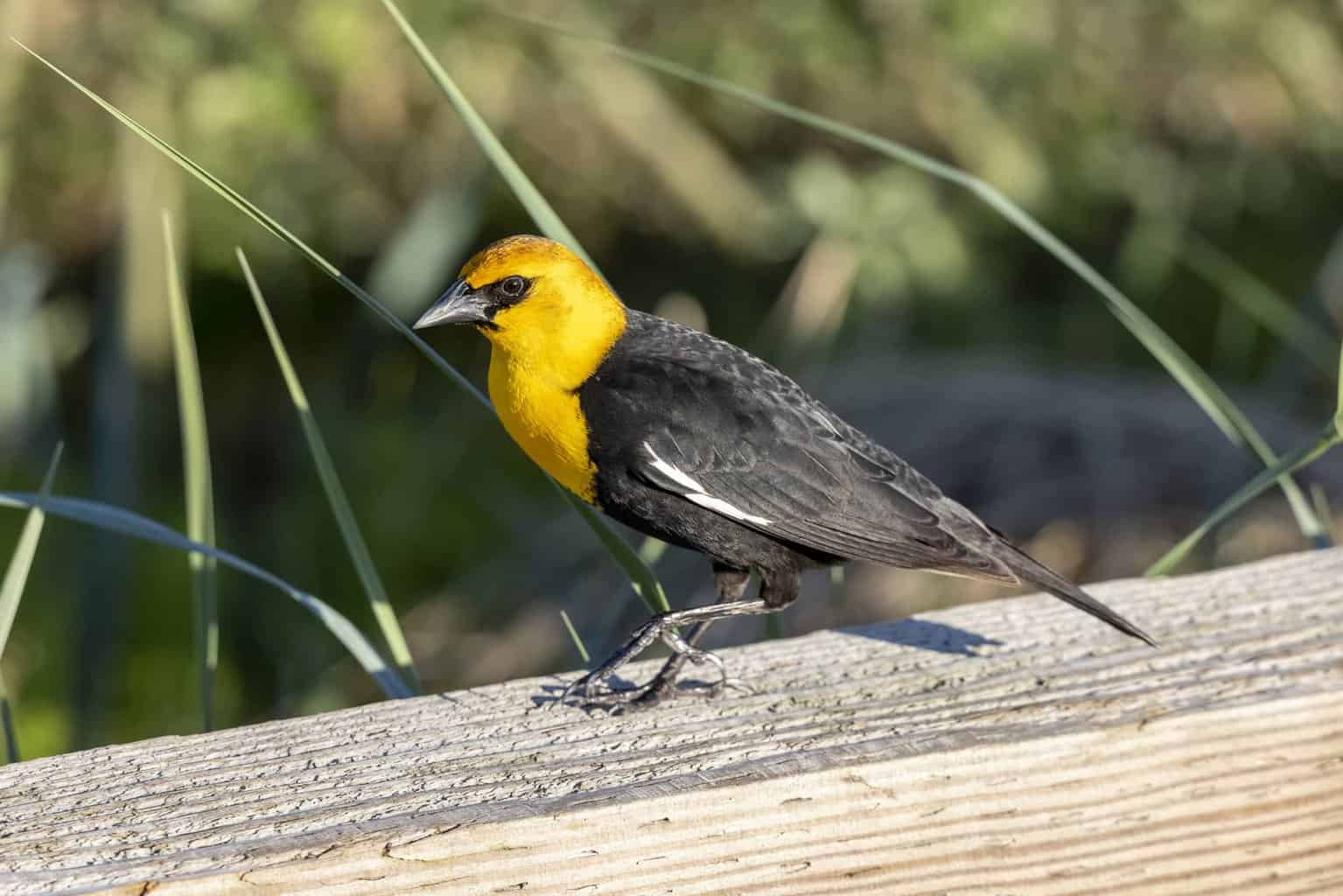
- Scientific Name: Xanthocephalus xanthocephalus
- Length: 8.3-10.2 in
- Weight: 1.6-3.5 oz
- Wingspan: 16.5-17.3 in
Additional Information:
The Yellow-headed Blackbirds have been around since the Pleistocene period, which is about 100,000 years ago. Their fossils were found in New Mexico, Utah, and California.
These birds are peculiar in more than their looks. Their flaming yellow heads contrast wildly with their pitch-black bodies. It’s a strong aggressive bird, especially with the Wrens that are known to destroy eggs. And at the same time, it’s a caring parent who helps in feeding the hatchlings.
The Yellow-headed Blackbirds are known to court and mate with up to eight females. But they’ll only settle down in one nest.
Western Meadowlark
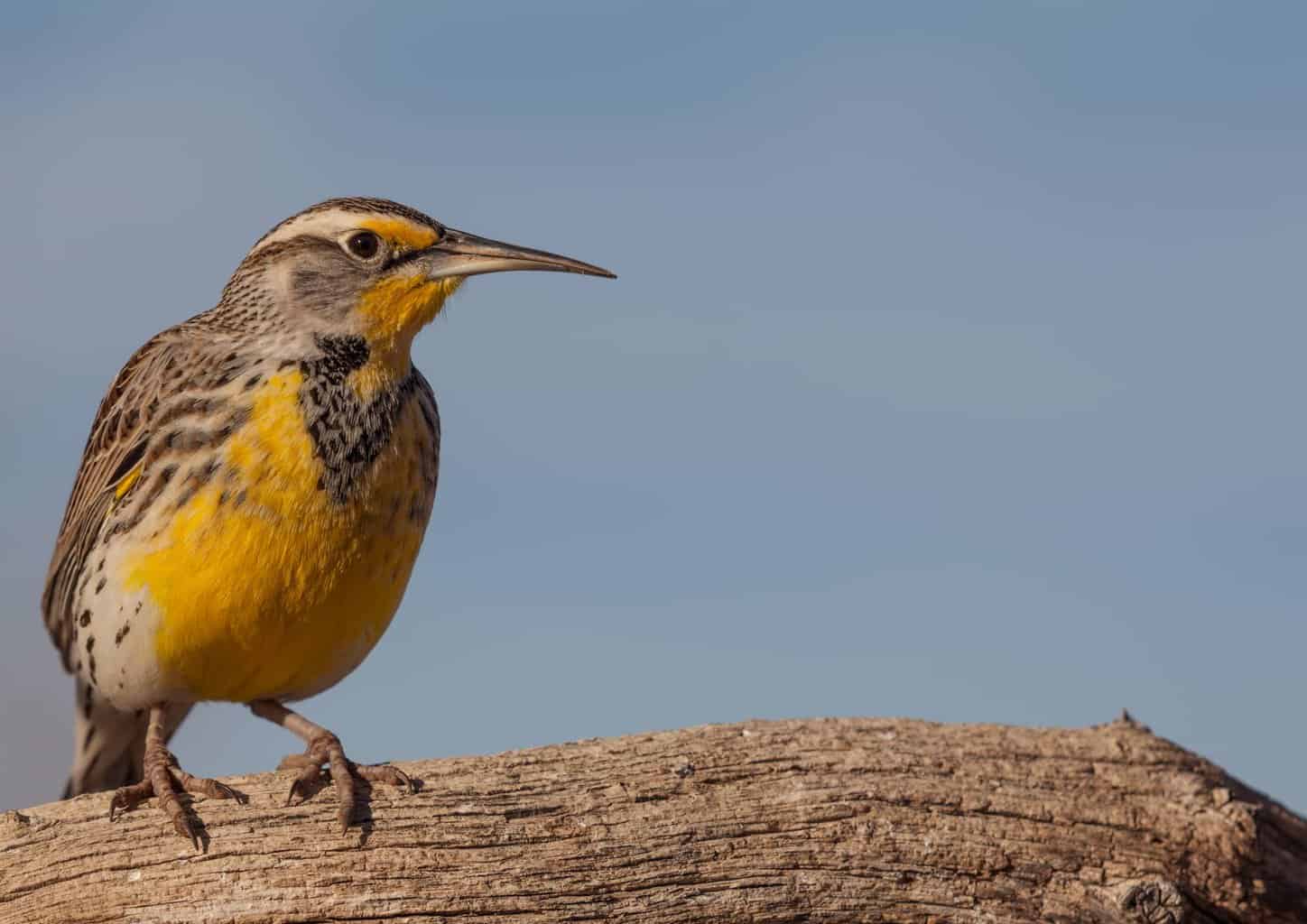
- Scientific Name: Sturnella neglecta
- Length: 6.3-10.2 in
- Weight: 3.1-4.1 oz
- Wingspan: 16.1 in
Additional Information:
The adult male Western Meadowlark is characterized by a yellow belly and patterned back. The juveniles are leaner and have fewer yellow patches.
These birds typically take residence in grasslands and set up their nests on the ground. And since they feed primarily on insects, this arrangement seems to work well for them.
Meadowlarks are songbirds that are easy to find once you follow the sweet tunes. You can find them at the fringes of fields, meadows, pastures, and even marshes.
Scott’s Oriole

- Scientific Name: Icterus parisorum
- Length: 9.1 in
- Weight: 1.1-1.4 oz
- Wingspan: 12.6 in
Additional Information:
The adult male Scott’s Oriole has an opposite coloring to the Yellow-headed Blackbird since this one has a shiny black head and a bright yellow body. The females are drastically different though, as they are more yellow with patterned grey wings.
Scott’s Orioles can be found in arid deserts as well as in mountain woodlands. They’re songbirds that brighten up the wilderness with their melodies. They feed on the fruits of palms, junipers, yuccas, and pines. And that’s where they build their hanging nests too.
American Goldfinch

- Scientific Name: Spinus tristis
- Length: 4.3-5.1 in
- Weight: 0.4-0.7 oz
- Wingspan: 7.5-8.7 in
Additional Information:
The breeding male American Goldfinch is a picturesque bird with a flaming yellow color and black highlights on its forehead and wings. After the spring season passes, these birds lose their bright colors. And as they start molting, they become rather patchy and odd-looking.
The best place to find these birds is in open woodlands, but they can also take residence in shrubs, open country, and around feeders.
Other Birds To Watch For in Nebraska
Phainopepla

- Scientific Name: Phainopepla nitens
- Length: 7.1-8.3 in
- Weight: 0.6-1.0 oz
- Wingspan: 10.6-11.4 in
Additional Information:
The Phainopeplas are jet-black birds with prominent disheveled crests, red eyes, and long tails. Their strange-sounding name comes from Greek, and it means “silky robe”. The males have glossy feathers, while the females tend to be matt and grey.
You can find these birds in desert scrub and the nearby woodlands. They enjoy perching on low-hanging branches and catching insects on the fly. They also feed on fruits, which they swallow whole.
European Starling
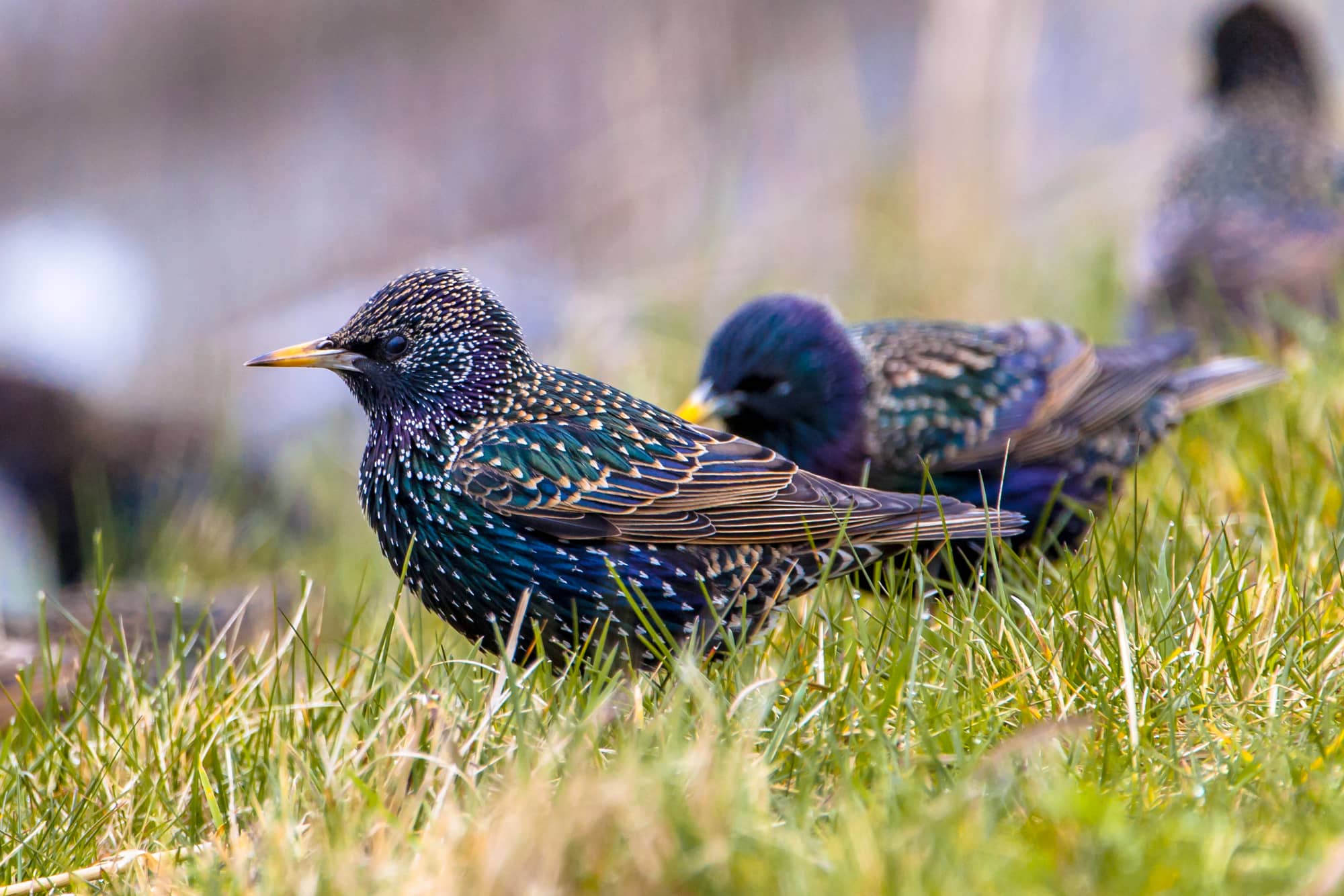
- Scientific Name: Sturnus vulgaris
- Length: 7.9-9.1 in
- Weight: 2.1-3.4 oz
- Wingspan: 12.2-15.8 in
Additional Information:
The European Starling is a Robin-sized bird with iridescent multicolored feathers on a slick black body.
It wasn’t a native bird in North America though. In the 19th century, it became fashionable among Shakespeare fans to own such a bird. They brought it along from Europe, and eventually, it became one of the common birds in the New World.
You can find it pretty much anywhere, in cities, small towns, or in the countryside. It has an odd zig-zag way of hopping around and might seem to be aggressive at times. However, it mostly just minds its own business.
Starlings like mimicking voices though, even those of cars, sirens, and machines.
Inca Dove
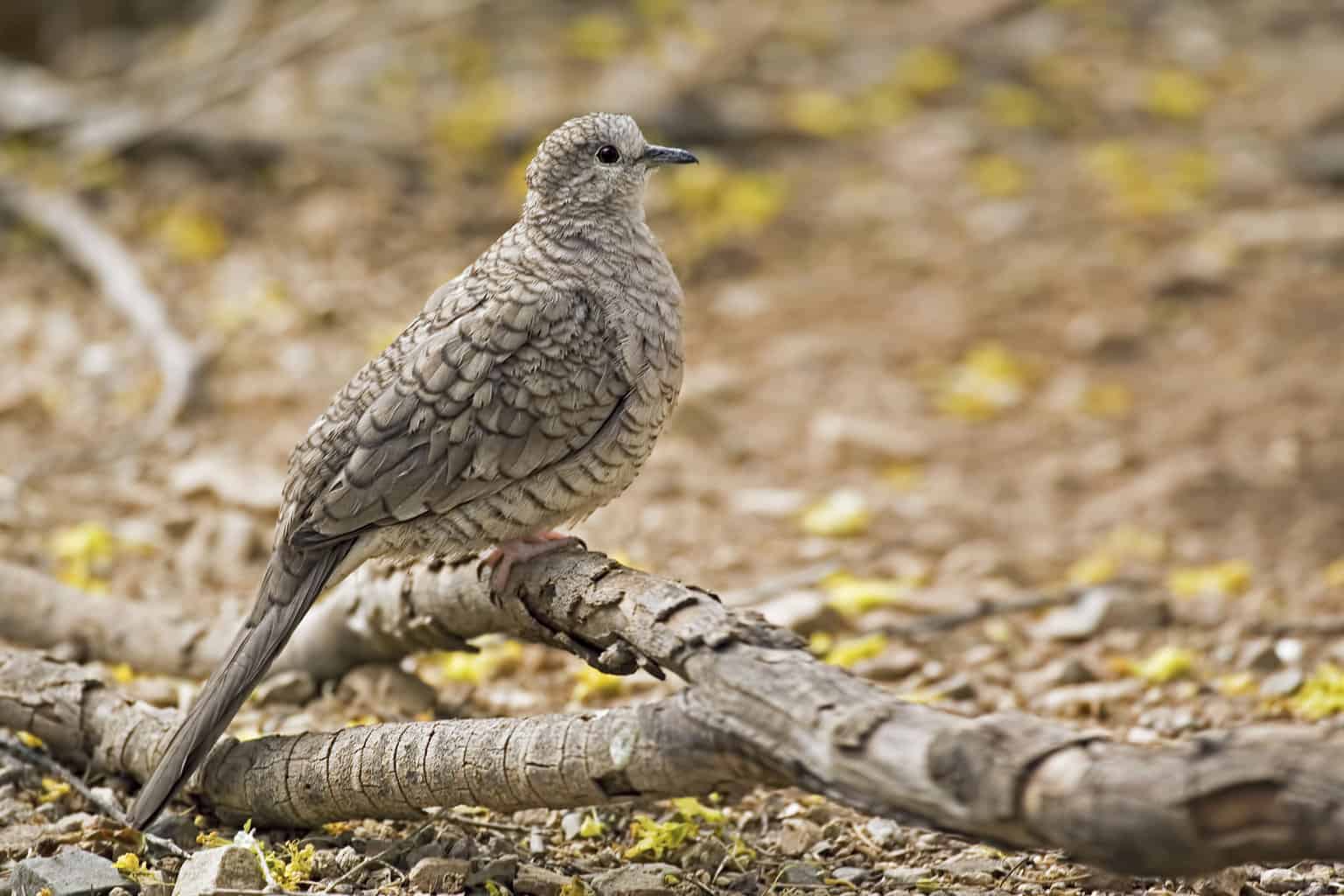
- Scientific Name: Columbina inca
- Length: 7.1-9.1 in
- Weight: 1.1-2.0 oz
- Wingspan: 12-13 in
Additional Information:
The Inca Dove is a smallish bird that’s slightly bigger than a swallow. Their feathers look more like puffed-up scales, and they have the camouflage color of stone or gravel.
This appearance makes the Inca Doves hard to discern, especially, when they’re standing quietly around concrete buildings and structures.
These birds are rumored to repeat the words “no hope”, but actually there’s probably “no truth” to this rumor!
And there’s certainly lots of hope to spot one of these doves around town. They’re quite sociable, and you could actually find them hopping right beside you.
Sabine’s Gull
- Scientific Name: Xema sabini
- Length: 13.4 in
- Weight: 5.5-7.5 oz
- Wingspan: 32-36 in
Additional Information:
Sabine’s Gull is a stout bird that’s primarily white, but the color contrast of its dark grey head, grey wings, and patterned black tail, make it absolutely picturesque. It also has a black border marking around its neck, which further defines its appearance.
These gulls are quite clever at foraging, so you can see them flying over the ocean and diving at a strategic moment to catch a fish.
They can also wade around tundra puddles, and look for plump worms or insects. At other times, they’d fly around the sea coast to pick a few crustaceans.
Sabine’s Gulls are arctic and subarctic birds that only appear in the warmer marches of the Midwest during the migration season.
Conclusion
We hope that you manage to spot and identify each one of the birds on this list. Nebraska is teeming with wildlife, and there’s always something more for the bird watchers to see.
You can also check out the 10 Hawks and 13 woodpeckers of Nebraska. They’re just as fascinating as the 25 birds listed here.

